Financial Management Assignment: Investment and Risk Analysis
VerifiedAdded on 2023/01/18
|10
|859
|72
Homework Assignment
AI Summary
This document presents a comprehensive solution to a financial management assignment, addressing several key areas. The assignment includes calculations and analysis related to investment products (Product Aee and Product Bee), bond valuation, and stock portfolio allocation. The student analyzes the impact of economic recession on investment returns, evaluates bond coupon rates and yields, and determines optimal stock allocations based on expected returns and risk. The solution also covers market risk premium calculation and identifies the riskiest asset within the portfolio. The assignment demonstrates the application of financial concepts such as time value of money, risk and return, and portfolio diversification to make sound financial decisions. The document includes tables, calculations, and bibliographical references.

Running head: FINANCIAL MANAGEMENT
Financial Management
Name of the Student:
Name of the University:
Author’s Note:
Course ID:
Financial Management
Name of the Student:
Name of the University:
Author’s Note:
Course ID:
Paraphrase This Document
Need a fresh take? Get an instant paraphrase of this document with our AI Paraphraser
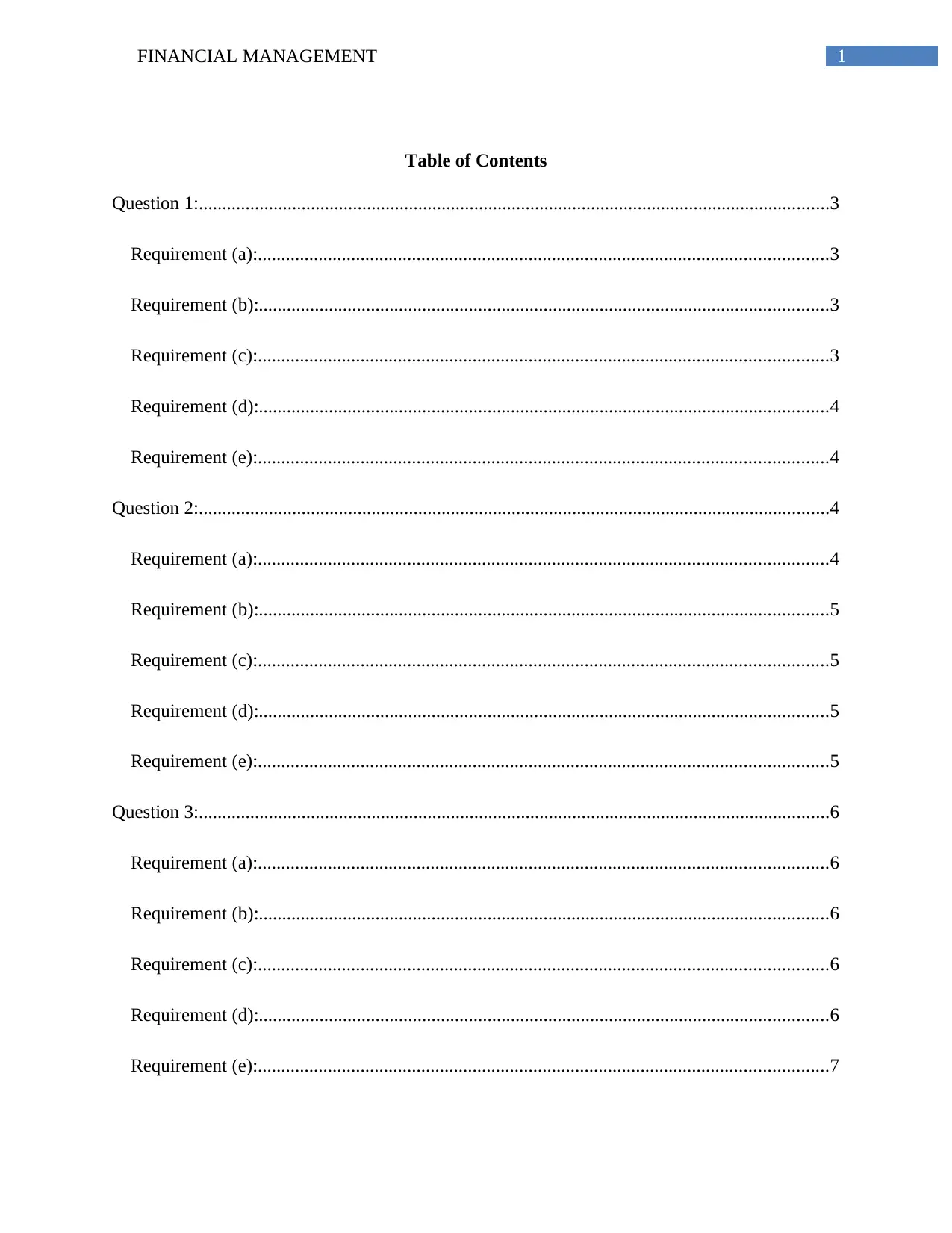
1FINANCIAL MANAGEMENT
Table of Contents
Question 1:.......................................................................................................................................3
Requirement (a):..........................................................................................................................3
Requirement (b):..........................................................................................................................3
Requirement (c):..........................................................................................................................3
Requirement (d):..........................................................................................................................4
Requirement (e):..........................................................................................................................4
Question 2:.......................................................................................................................................4
Requirement (a):..........................................................................................................................4
Requirement (b):..........................................................................................................................5
Requirement (c):..........................................................................................................................5
Requirement (d):..........................................................................................................................5
Requirement (e):..........................................................................................................................5
Question 3:.......................................................................................................................................6
Requirement (a):..........................................................................................................................6
Requirement (b):..........................................................................................................................6
Requirement (c):..........................................................................................................................6
Requirement (d):..........................................................................................................................6
Requirement (e):..........................................................................................................................7
Table of Contents
Question 1:.......................................................................................................................................3
Requirement (a):..........................................................................................................................3
Requirement (b):..........................................................................................................................3
Requirement (c):..........................................................................................................................3
Requirement (d):..........................................................................................................................4
Requirement (e):..........................................................................................................................4
Question 2:.......................................................................................................................................4
Requirement (a):..........................................................................................................................4
Requirement (b):..........................................................................................................................5
Requirement (c):..........................................................................................................................5
Requirement (d):..........................................................................................................................5
Requirement (e):..........................................................................................................................5
Question 3:.......................................................................................................................................6
Requirement (a):..........................................................................................................................6
Requirement (b):..........................................................................................................................6
Requirement (c):..........................................................................................................................6
Requirement (d):..........................................................................................................................6
Requirement (e):..........................................................................................................................7
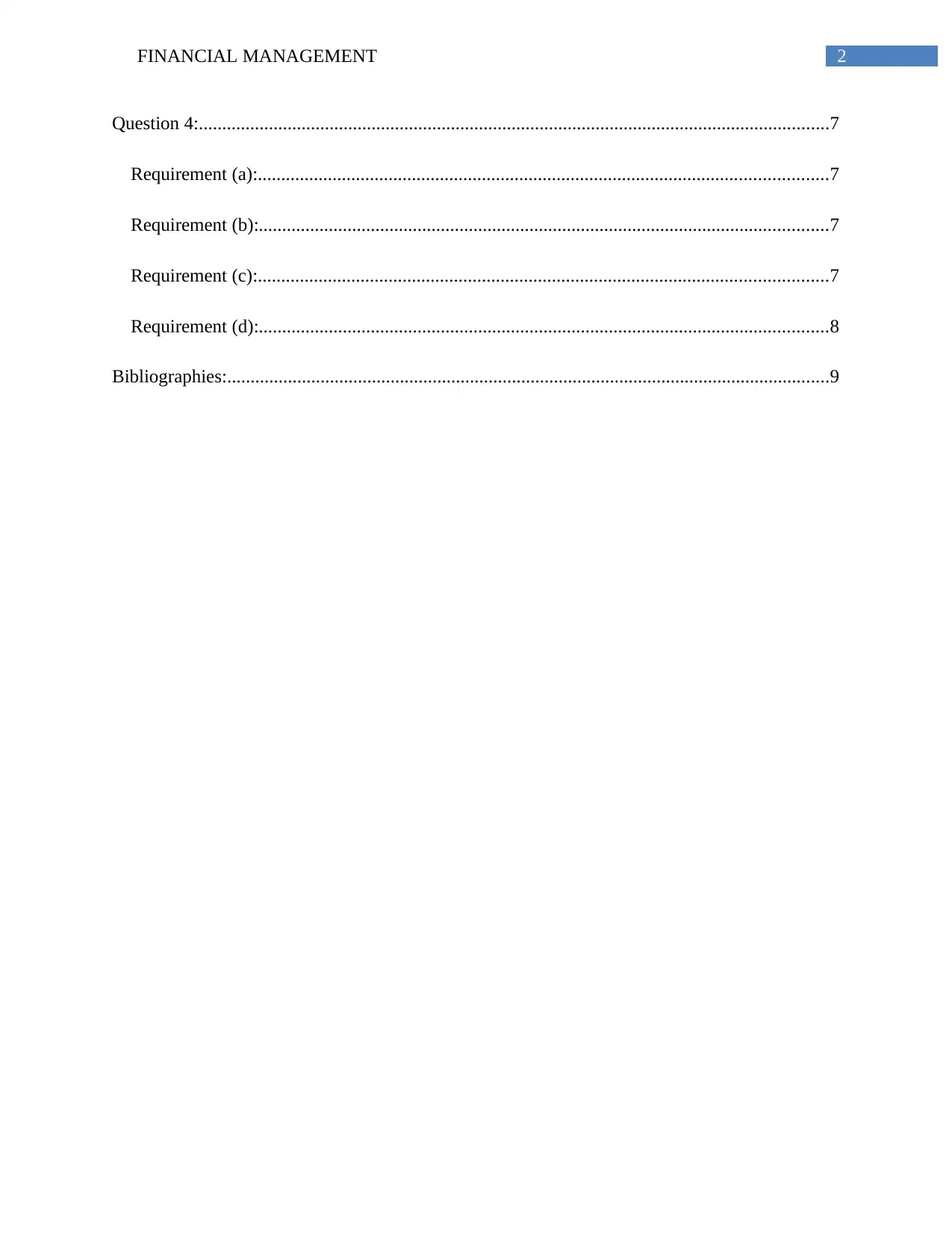
2FINANCIAL MANAGEMENT
Question 4:.......................................................................................................................................7
Requirement (a):..........................................................................................................................7
Requirement (b):..........................................................................................................................7
Requirement (c):..........................................................................................................................7
Requirement (d):..........................................................................................................................8
Bibliographies:.................................................................................................................................9
Question 4:.......................................................................................................................................7
Requirement (a):..........................................................................................................................7
Requirement (b):..........................................................................................................................7
Requirement (c):..........................................................................................................................7
Requirement (d):..........................................................................................................................8
Bibliographies:.................................................................................................................................9
⊘ This is a preview!⊘
Do you want full access?
Subscribe today to unlock all pages.

Trusted by 1+ million students worldwide
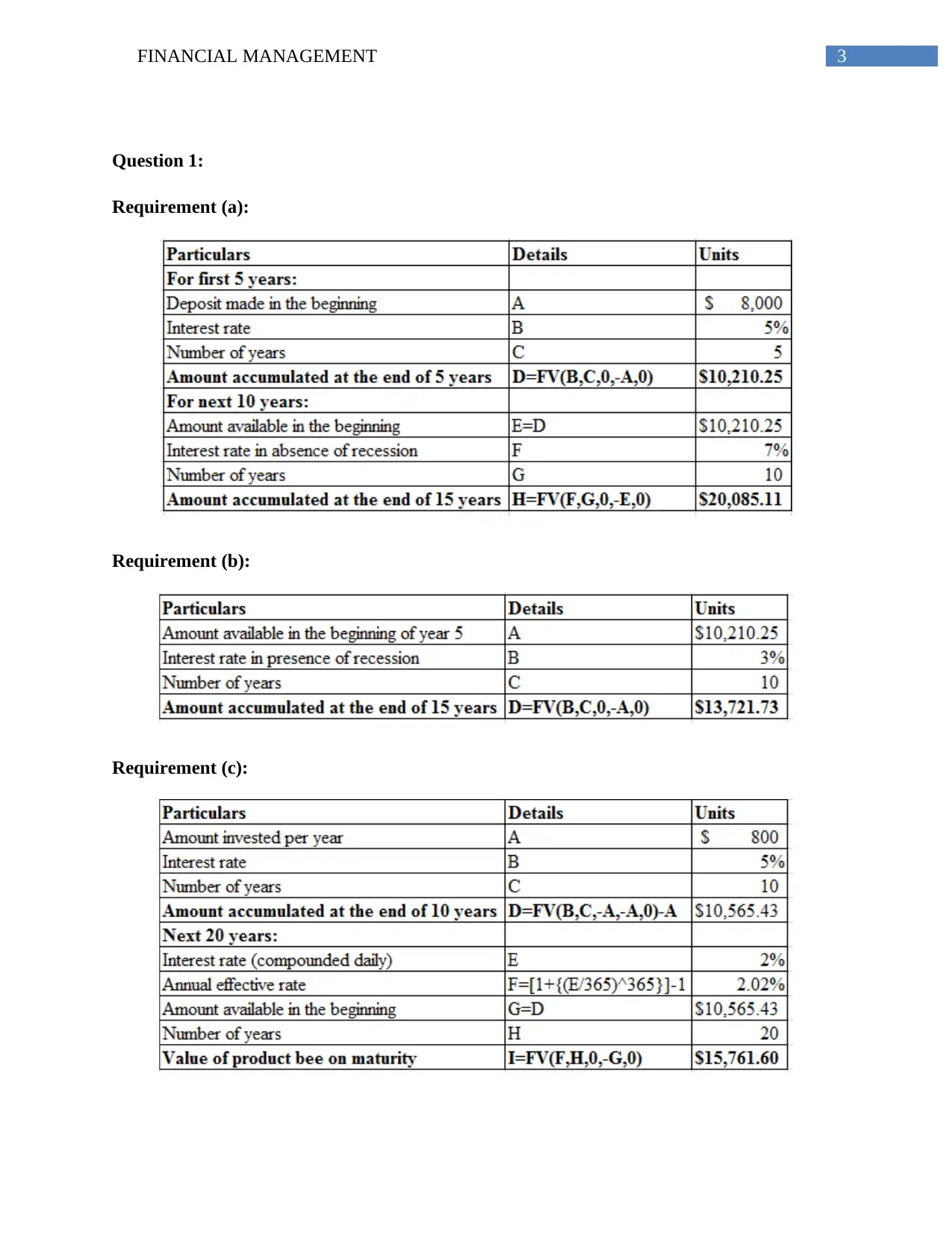
3FINANCIAL MANAGEMENT
Question 1:
Requirement (a):
Requirement (b):
Requirement (c):
Question 1:
Requirement (a):
Requirement (b):
Requirement (c):
Paraphrase This Document
Need a fresh take? Get an instant paraphrase of this document with our AI Paraphraser
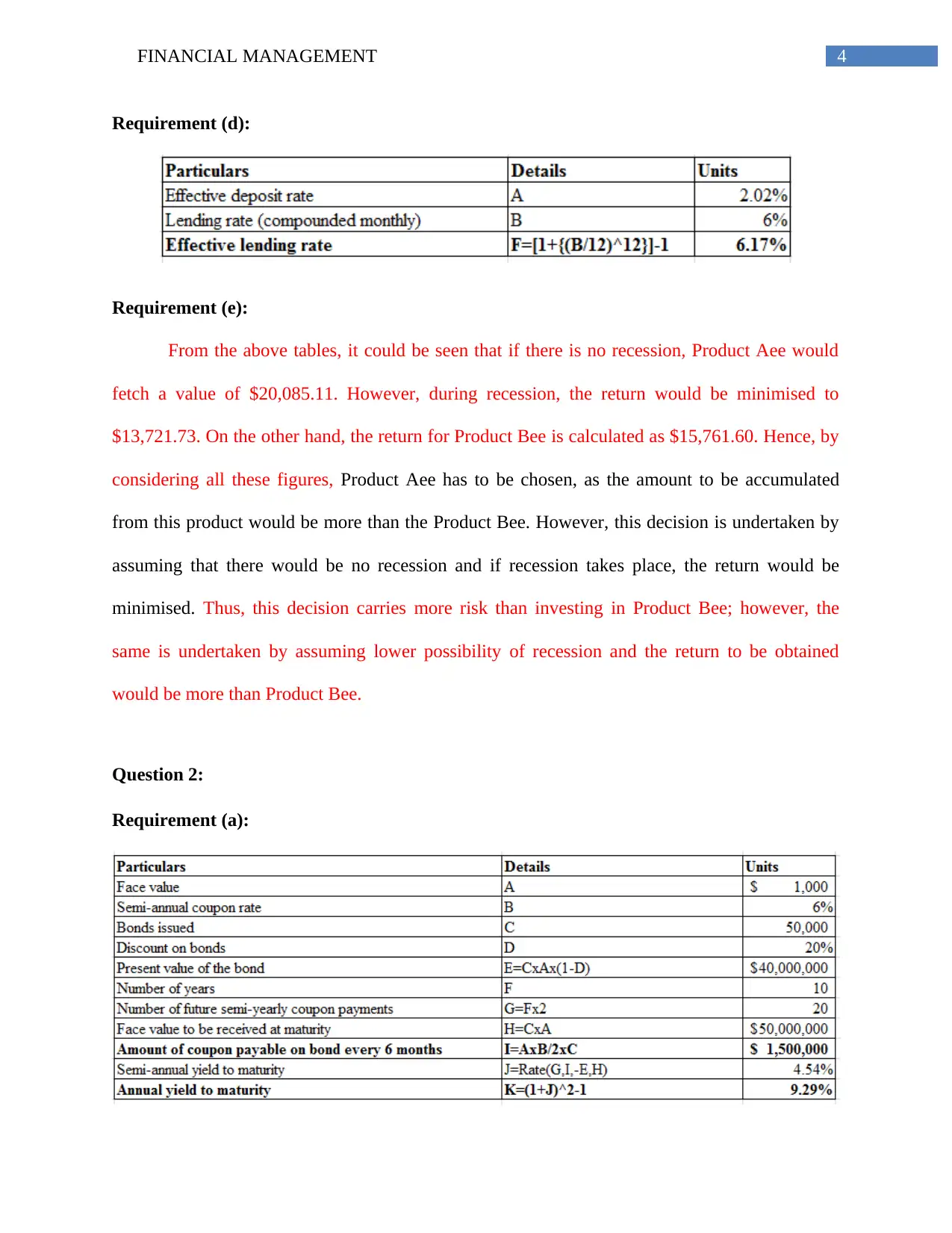
4FINANCIAL MANAGEMENT
Requirement (d):
Requirement (e):
From the above tables, it could be seen that if there is no recession, Product Aee would
fetch a value of $20,085.11. However, during recession, the return would be minimised to
$13,721.73. On the other hand, the return for Product Bee is calculated as $15,761.60. Hence, by
considering all these figures, Product Aee has to be chosen, as the amount to be accumulated
from this product would be more than the Product Bee. However, this decision is undertaken by
assuming that there would be no recession and if recession takes place, the return would be
minimised. Thus, this decision carries more risk than investing in Product Bee; however, the
same is undertaken by assuming lower possibility of recession and the return to be obtained
would be more than Product Bee.
Question 2:
Requirement (a):
Requirement (d):
Requirement (e):
From the above tables, it could be seen that if there is no recession, Product Aee would
fetch a value of $20,085.11. However, during recession, the return would be minimised to
$13,721.73. On the other hand, the return for Product Bee is calculated as $15,761.60. Hence, by
considering all these figures, Product Aee has to be chosen, as the amount to be accumulated
from this product would be more than the Product Bee. However, this decision is undertaken by
assuming that there would be no recession and if recession takes place, the return would be
minimised. Thus, this decision carries more risk than investing in Product Bee; however, the
same is undertaken by assuming lower possibility of recession and the return to be obtained
would be more than Product Bee.
Question 2:
Requirement (a):
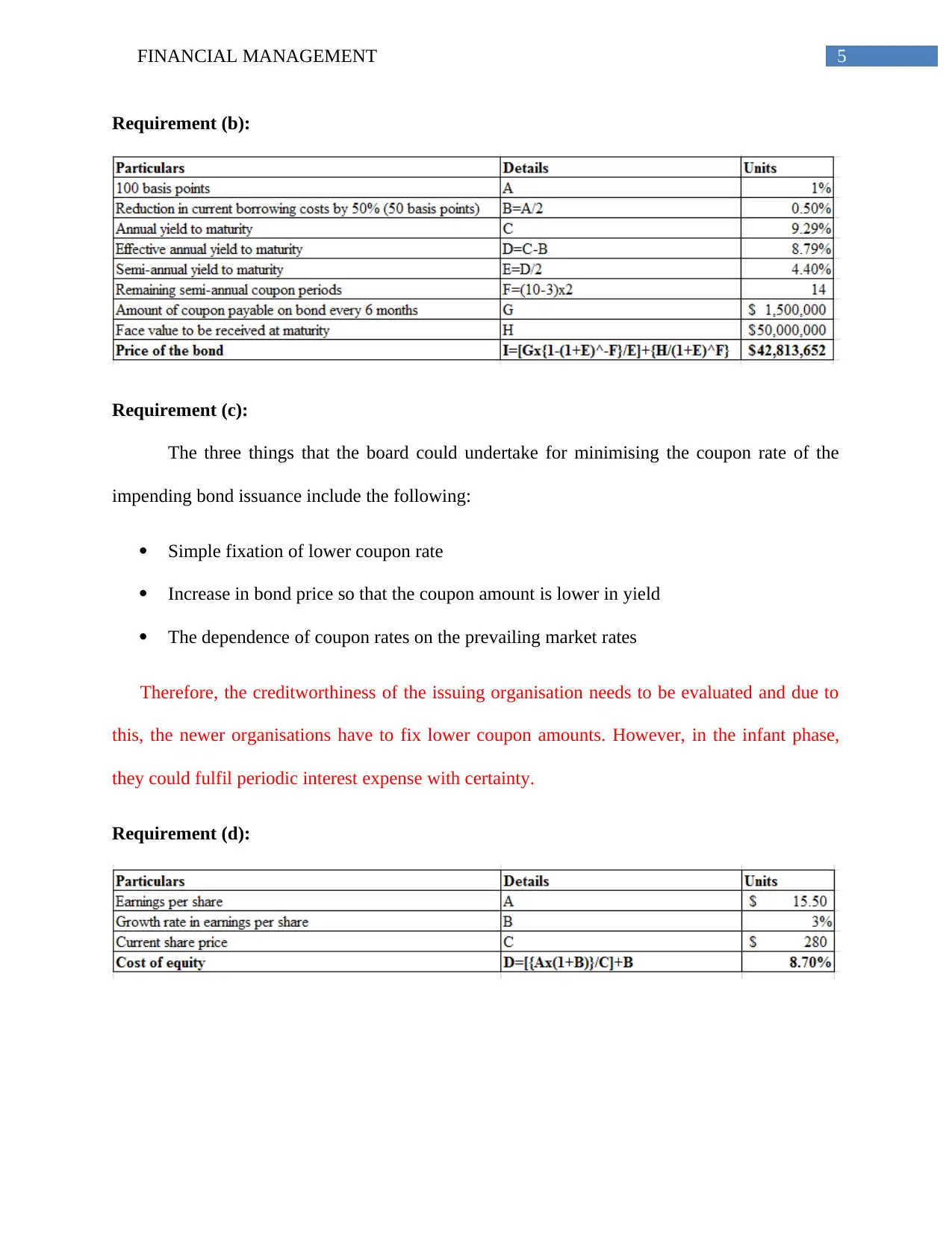
5FINANCIAL MANAGEMENT
Requirement (b):
Requirement (c):
The three things that the board could undertake for minimising the coupon rate of the
impending bond issuance include the following:
Simple fixation of lower coupon rate
Increase in bond price so that the coupon amount is lower in yield
The dependence of coupon rates on the prevailing market rates
Therefore, the creditworthiness of the issuing organisation needs to be evaluated and due to
this, the newer organisations have to fix lower coupon amounts. However, in the infant phase,
they could fulfil periodic interest expense with certainty.
Requirement (d):
Requirement (b):
Requirement (c):
The three things that the board could undertake for minimising the coupon rate of the
impending bond issuance include the following:
Simple fixation of lower coupon rate
Increase in bond price so that the coupon amount is lower in yield
The dependence of coupon rates on the prevailing market rates
Therefore, the creditworthiness of the issuing organisation needs to be evaluated and due to
this, the newer organisations have to fix lower coupon amounts. However, in the infant phase,
they could fulfil periodic interest expense with certainty.
Requirement (d):
⊘ This is a preview!⊘
Do you want full access?
Subscribe today to unlock all pages.

Trusted by 1+ million students worldwide
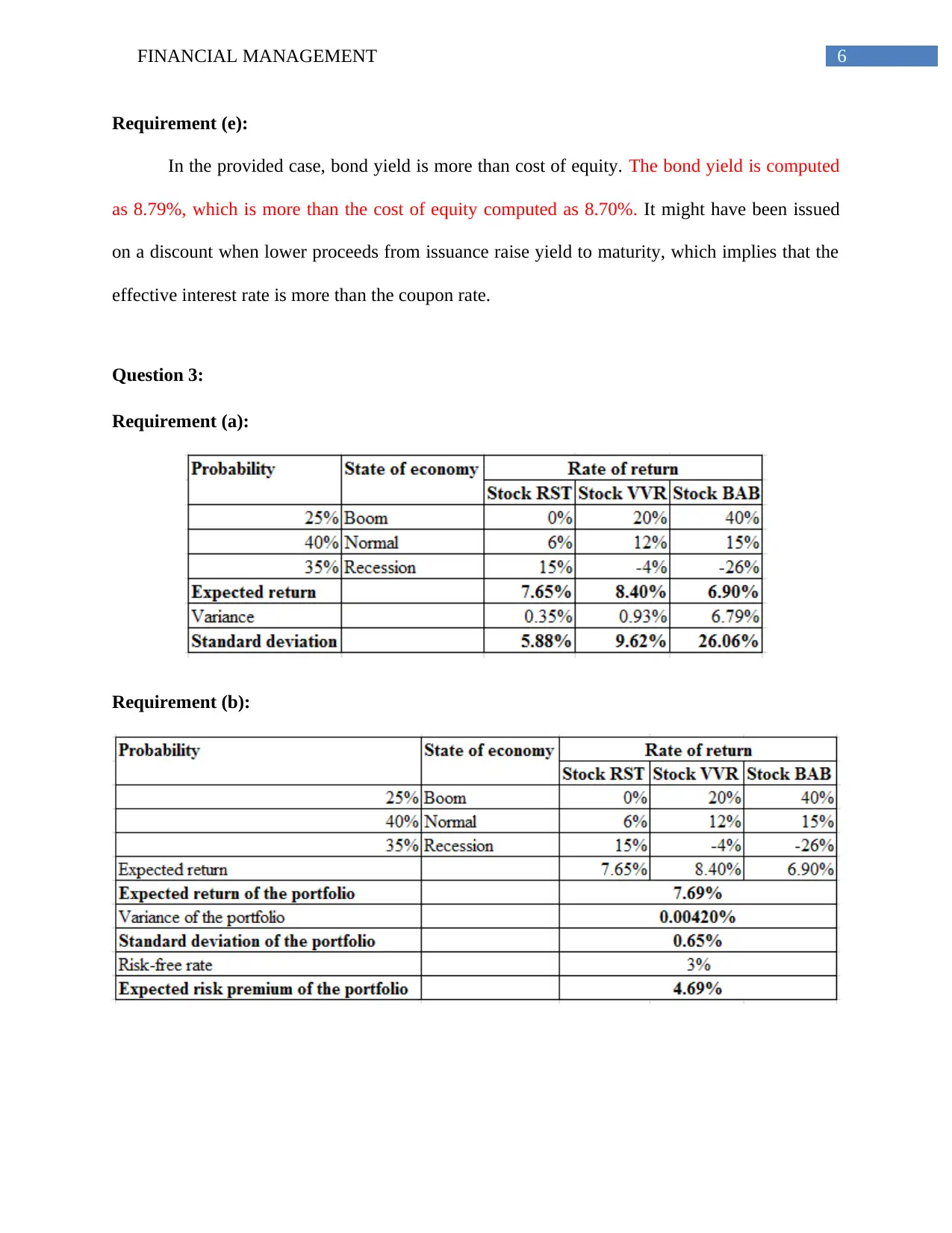
6FINANCIAL MANAGEMENT
Requirement (e):
In the provided case, bond yield is more than cost of equity. The bond yield is computed
as 8.79%, which is more than the cost of equity computed as 8.70%. It might have been issued
on a discount when lower proceeds from issuance raise yield to maturity, which implies that the
effective interest rate is more than the coupon rate.
Question 3:
Requirement (a):
Requirement (b):
Requirement (e):
In the provided case, bond yield is more than cost of equity. The bond yield is computed
as 8.79%, which is more than the cost of equity computed as 8.70%. It might have been issued
on a discount when lower proceeds from issuance raise yield to maturity, which implies that the
effective interest rate is more than the coupon rate.
Question 3:
Requirement (a):
Requirement (b):
Paraphrase This Document
Need a fresh take? Get an instant paraphrase of this document with our AI Paraphraser
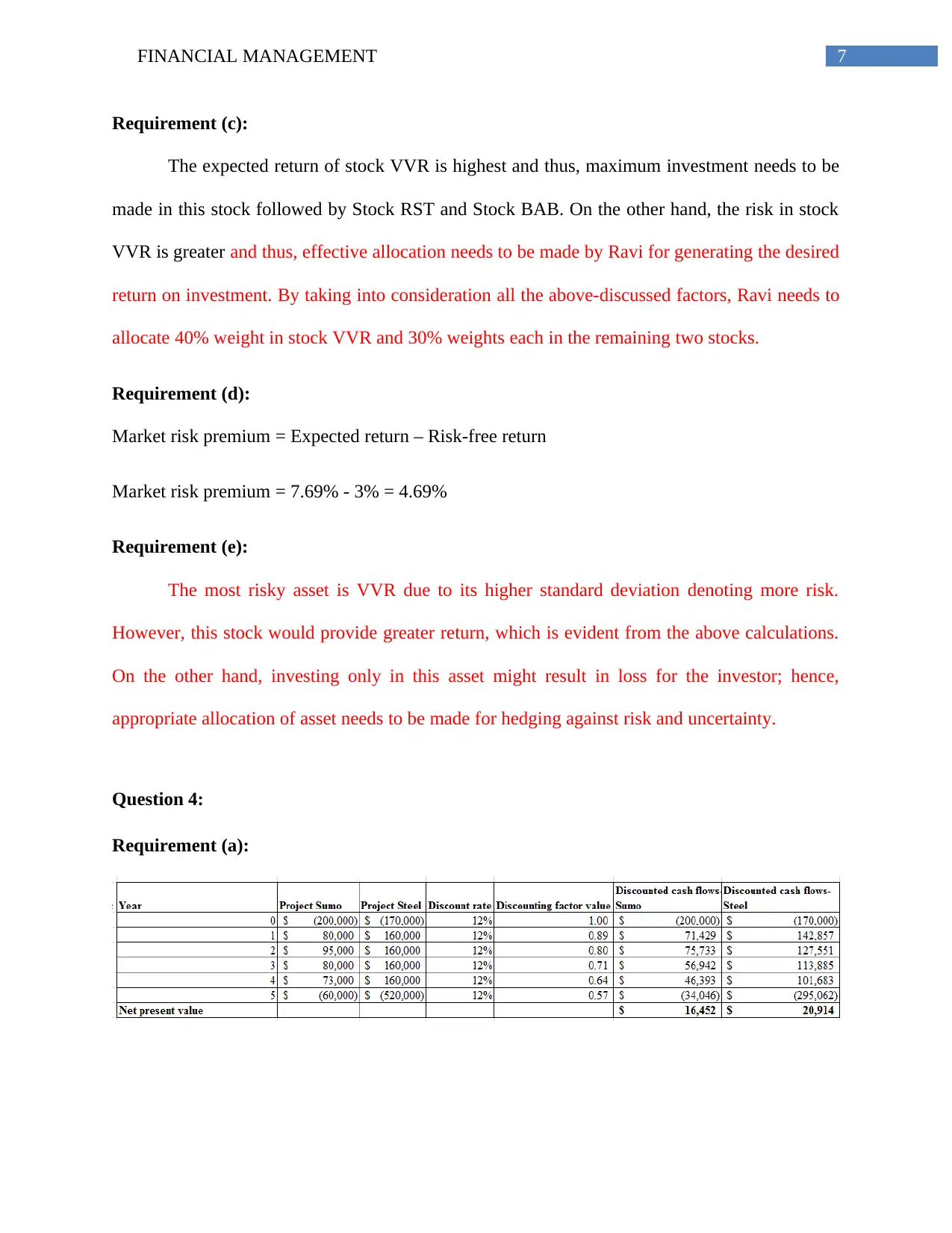
7FINANCIAL MANAGEMENT
Requirement (c):
The expected return of stock VVR is highest and thus, maximum investment needs to be
made in this stock followed by Stock RST and Stock BAB. On the other hand, the risk in stock
VVR is greater and thus, effective allocation needs to be made by Ravi for generating the desired
return on investment. By taking into consideration all the above-discussed factors, Ravi needs to
allocate 40% weight in stock VVR and 30% weights each in the remaining two stocks.
Requirement (d):
Market risk premium = Expected return – Risk-free return
Market risk premium = 7.69% - 3% = 4.69%
Requirement (e):
The most risky asset is VVR due to its higher standard deviation denoting more risk.
However, this stock would provide greater return, which is evident from the above calculations.
On the other hand, investing only in this asset might result in loss for the investor; hence,
appropriate allocation of asset needs to be made for hedging against risk and uncertainty.
Question 4:
Requirement (a):
Requirement (c):
The expected return of stock VVR is highest and thus, maximum investment needs to be
made in this stock followed by Stock RST and Stock BAB. On the other hand, the risk in stock
VVR is greater and thus, effective allocation needs to be made by Ravi for generating the desired
return on investment. By taking into consideration all the above-discussed factors, Ravi needs to
allocate 40% weight in stock VVR and 30% weights each in the remaining two stocks.
Requirement (d):
Market risk premium = Expected return – Risk-free return
Market risk premium = 7.69% - 3% = 4.69%
Requirement (e):
The most risky asset is VVR due to its higher standard deviation denoting more risk.
However, this stock would provide greater return, which is evident from the above calculations.
On the other hand, investing only in this asset might result in loss for the investor; hence,
appropriate allocation of asset needs to be made for hedging against risk and uncertainty.
Question 4:
Requirement (a):

8FINANCIAL MANAGEMENT
Requirement (b):
Requirement (c):
Requirement (d):
Requirement (b):
Requirement (c):
Requirement (d):
⊘ This is a preview!⊘
Do you want full access?
Subscribe today to unlock all pages.

Trusted by 1+ million students worldwide
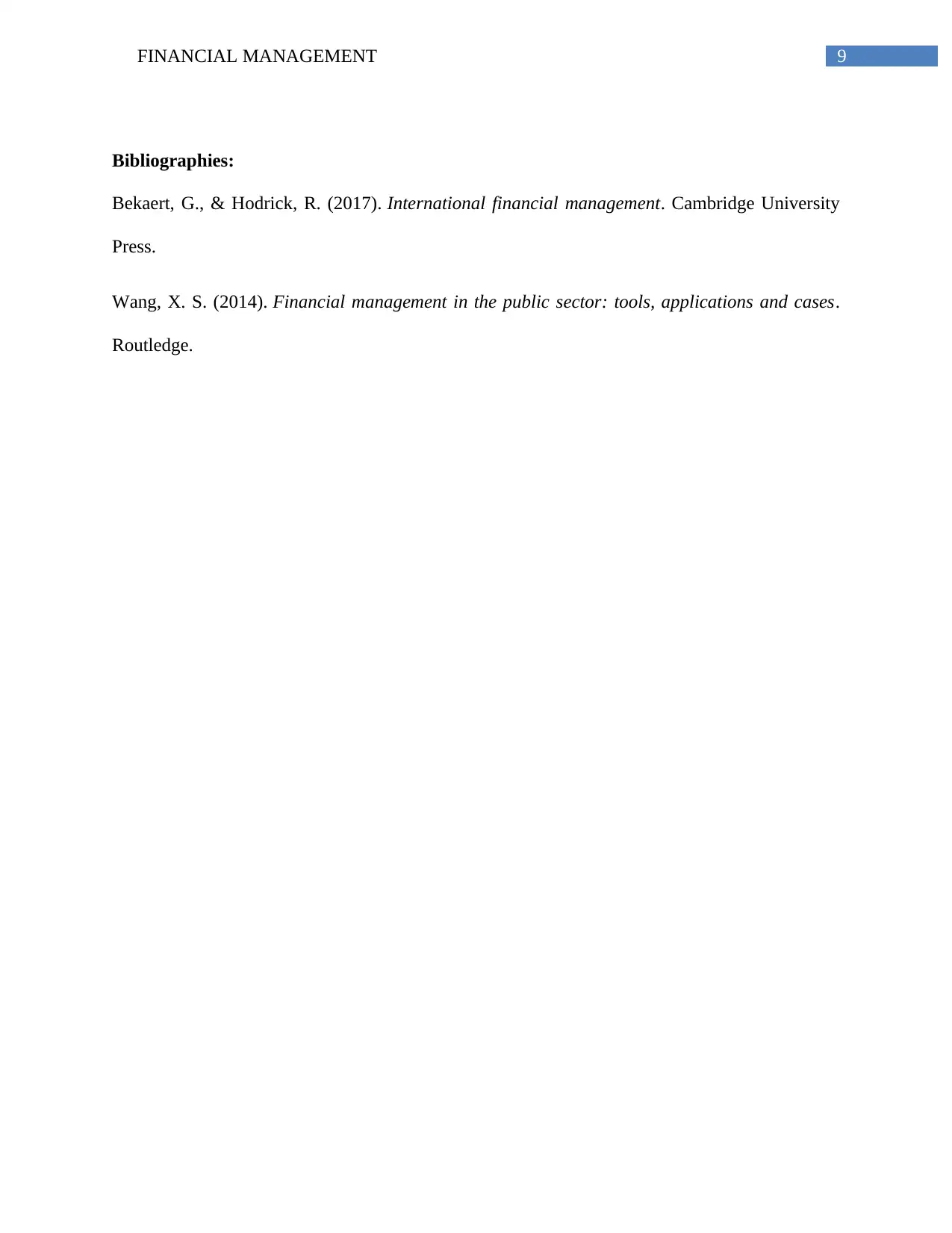
9FINANCIAL MANAGEMENT
Bibliographies:
Bekaert, G., & Hodrick, R. (2017). International financial management. Cambridge University
Press.
Wang, X. S. (2014). Financial management in the public sector: tools, applications and cases.
Routledge.
Bibliographies:
Bekaert, G., & Hodrick, R. (2017). International financial management. Cambridge University
Press.
Wang, X. S. (2014). Financial management in the public sector: tools, applications and cases.
Routledge.
1 out of 10
Related Documents
Your All-in-One AI-Powered Toolkit for Academic Success.
+13062052269
info@desklib.com
Available 24*7 on WhatsApp / Email
![[object Object]](/_next/static/media/star-bottom.7253800d.svg)
Unlock your academic potential
Copyright © 2020–2025 A2Z Services. All Rights Reserved. Developed and managed by ZUCOL.





